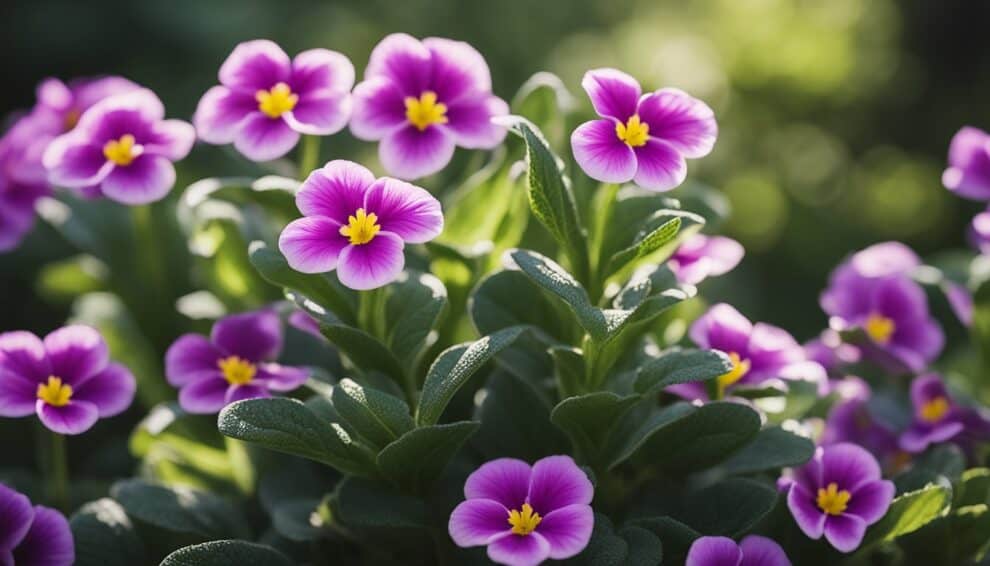Cape Primrose, also known as Streptocarpus spp., is a popular houseplant due to its stunning velvety flowers. These plants are native to Africa and have become a favorite among gardeners worldwide due to their ease of care and propagation. In this article, we will delve into the world of Cape Primrose propagation, exploring the different methods that can be used to propagate these beautiful plants.

One of the reasons why Cape Primrose is so popular among gardeners is its ability to produce an abundance of flowers throughout the year. However, as with any plant, there comes a time when it needs to be propagated to maintain its health and vigor. Fortunately, Cape Primrose is one of the easiest plants to propagate, making it a great choice for novice gardeners.
Propagation can be done through various methods, including division, leaf cuttings, and seed propagation. Each method has its own advantages and disadvantages, and the choice of method depends on the gardener’s preference and the plant’s needs. In the following paragraphs, we will discuss each method in detail, providing step-by-step instructions on how to propagate Cape Primrose successfully.
Understanding Cape Primrose

Species Overview
Cape Primrose, also known as Streptocarpus spp., is a genus of flowering plants in the family Gesneriaceae. It is native to Southern Africa and Madagascar. There are around 150 species of Cape Primrose, which can be found in a wide range of colors, including pink, purple, blue, white, and red. The flowers are velvety and have a charming appearance.
Growth Habits
Cape Primrose is a perennial plant that can grow up to 12 inches in height. It has a rosette of leaves that grow from the base of the plant. The leaves are dark green and have a velvety texture. The plant produces a long stem that bears clusters of flowers. The flowers bloom in the spring and summer months.
Cape Primrose prefers a well-draining soil that is rich in organic matter. It requires moderate watering and should be fertilized every two weeks during the growing season. The plant can be propagated by leaf cuttings or division. It is a relatively easy plant to grow and is popular among gardeners and plant enthusiasts.
In conclusion, Cape Primrose is a beautiful and charming plant that is easy to grow and propagate. Its velvety flowers and dark green leaves make it a popular choice among gardeners. With proper care and maintenance, Cape Primrose can thrive and bring joy to any indoor or outdoor space.
Propagation Basics

Choosing the Right Time
Cape Primrose plants are generally propagated during the spring and summer months. During these months, the plants are actively growing and will respond better to propagation techniques. It is important to avoid propagating during the winter months as the plants are often dormant and may not respond well to propagation.
Propagation Methods
There are several methods of propagating Cape Primrose plants, including leaf cuttings, stem cuttings, and division.
Leaf Cuttings
Leaf cuttings are a popular method of propagating Cape Primrose plants. To propagate using this method, take a healthy leaf and cut it into several sections, ensuring that each section has a vein. The sections should then be planted in a well-draining soil mix and kept moist until roots and new leaves form.
Stem Cuttings
Stem cuttings can also be used to propagate Cape Primrose plants. To propagate using this method, take a healthy stem and cut it into several sections, ensuring that each section has a few leaves. The sections should then be planted in a well-draining soil mix and kept moist until roots and new leaves form.
Division
Division is another method of propagating Cape Primrose plants. To propagate using this method, carefully remove the plant from its pot and separate the plant into smaller sections, ensuring that each section has roots and leaves. The sections should then be replanted in a well-draining soil mix and kept moist until new growth appears.
Overall, Cape Primrose plants are relatively easy to propagate using various techniques. With the right timing and proper care, gardeners can easily propagate these beautiful plants and enjoy their velvety charms in their own gardens.
Propagation Step-by-Step

Leaf Cuttings
Leaf cuttings are the most common method of propagating Cape Primrose. Follow these simple steps to propagate your own Velvety Charms:
- Choose a healthy leaf with no signs of disease or damage.
- Cut the leaf at the base where it meets the stem.
- Cut the leaf into sections, making sure each section has a vein running through it.
- Dip the cut ends of the leaf sections in rooting hormone.
- Plant the leaf sections in a potting mix consisting of equal parts peat moss and perlite.
- Water the soil and cover the pot with a plastic bag to create a humid environment.
- Place the pot in a bright, indirect light location.
- Keep the soil moist but not waterlogged.
- After a few weeks, new growth should appear from the base of the leaf sections.
- Once the new growth has developed roots and a few leaves, the new plant can be transplanted into its own pot.
Seed Starting
Starting Cape Primrose from seed can be a bit more challenging than leaf cuttings, but it is still a viable option. Here’s how to do it:
- Collect seeds from a mature Cape Primrose plant.
- Soak the seeds in water for a few hours to soften the outer coating.
- Plant the seeds in a potting mix consisting of equal parts peat moss and perlite.
- Cover the pot with a plastic bag to create a humid environment.
- Place the pot in a bright, indirect light location.
- Keep the soil moist but not waterlogged.
- After a few weeks, the seeds should start to germinate.
- Once the seedlings have a few leaves, they can be transplanted into their own pots.
Division
Dividing a mature Cape Primrose plant is another way to propagate it. Here’s how:
- Carefully remove the plant from its pot.
- Gently separate the roots into sections, making sure each section has a few leaves attached.
- Plant each section in its own pot with a potting mix consisting of equal parts peat moss and perlite.
- Water the soil and cover the pot with a plastic bag to create a humid environment.
- Place the pot in a bright, indirect light location.
- Keep the soil moist but not waterlogged.
- After a few weeks, new growth should appear from each section.
- Once the new growth has developed roots and a few leaves, the new plants can be transplanted into their own pots.
Aftercare and Troubleshooting

Post-Propagation Care
After propagating Cape Primrose, it is important to provide proper care to ensure their healthy growth. Here are some tips for post-propagation care:
- Watering: Keep the soil moist but not waterlogged. Overwatering can lead to root rot, while underwatering can cause the plant to wilt. Water the plant when the top inch of soil feels dry to the touch.
- Lighting: Cape Primrose prefers bright but indirect light. Direct sunlight can scorch the leaves, while low light can cause the plant to become leggy.
- Fertilizing: Feed the plant with a balanced fertilizer every two weeks during the growing season. Avoid fertilizing during the dormant period.
- Temperature: Cape Primrose prefers temperatures between 60-75°F (15-24°C). Avoid exposing the plant to extreme temperatures or drafts.
Common Issues
Despite proper care, Cape Primrose may encounter some issues. Here are some common problems and their solutions:
- Yellowing Leaves: Yellowing leaves can be a sign of overwatering, underwatering, nutrient deficiency, or pests. Check the soil moisture, adjust watering frequency, and fertilize the plant as needed. Inspect the plant for pests and treat accordingly.
- Wilting Leaves: Wilting leaves can be a sign of underwatering or root rot. Check the soil moisture and adjust watering frequency. If the roots are mushy and discolored, remove the affected roots and repot the plant in fresh soil.
- Pests: Cape Primrose may be prone to spider mites, mealybugs, and thrips. Inspect the plant regularly and treat with insecticidal soap or neem oil if necessary.
- Dormancy: Cape Primrose may enter a dormant period during the winter months. Reduce watering frequency and stop fertilizing during this time. The plant will resume growth in the spring.
Frequently Asked Questions
What are the steps for propagating Streptocarpus using leaf cuttings?
To propagate Streptocarpus using leaf cuttings, follow these steps:
- Select a healthy leaf from the plant.
- Cut the leaf into sections, making sure each section has a vein.
- Dip the cut end of each section in rooting hormone.
- Plant the sections in a well-draining soil mix and keep them moist.
- Cover the pot with a plastic bag or dome to create a humid environment.
- Place the pot in a bright, indirect light.
- Wait for new growth to appear before removing the cover.
How can I propagate Cape Primrose in water?
To propagate Cape Primrose in water, follow these steps:
- Select a healthy leaf from the plant.
- Cut the leaf into sections, making sure each section has a vein.
- Place the sections in a jar or vase filled with water.
- Change the water every few days to prevent the growth of bacteria.
- Wait for new growth to appear before transplanting the sections into soil.
Can Streptocarpus be propagated through division, and if so, how?
Yes, Streptocarpus can be propagated through division. To do so, follow these steps:
- Carefully remove the plant from its pot.
- Gently separate the plant into smaller sections, making sure each section has roots.
- Plant each section in a well-draining soil mix.
- Keep the soil moist and place the plants in a bright, indirect light.
What should I do if my Streptocarpus isn’t flowering?
If your Streptocarpus isn’t flowering, there are a few things you can try:
- Make sure the plant is getting enough light. Streptocarpus prefers bright, indirect light.
- Check the temperature. Streptocarpus prefers temperatures between 60-75°F.
- Make sure the plant is getting enough water. Streptocarpus prefers moist soil, but not waterlogged.
- Fertilize the plant with a balanced fertilizer every 2-3 weeks during the growing season.
Where can I find Streptocarpus plants for sale?
Streptocarpus plants can be found at nurseries, garden centers, and online plant retailers.
Is it possible to propagate Streptocarpella in the same way as Streptocarpus?
Yes, Streptocarpella can be propagated in the same way as Streptocarpus.













